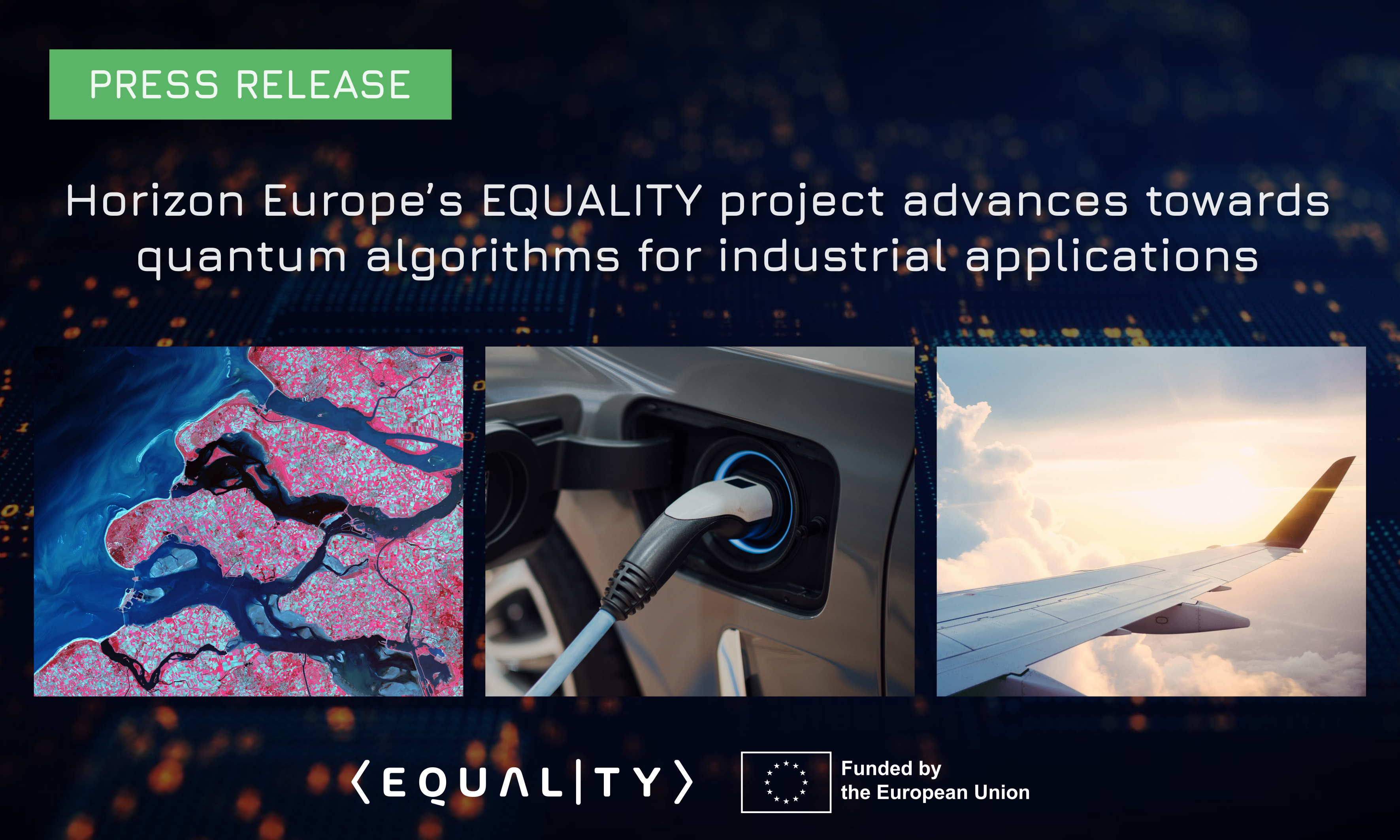

The project’s goal is to develop a full stack of technologies aimed at bringing practical advantage of quantum computing to the industry in the near term. Read our new press release.
Quantum computing is one of the frontiers of research and innovation due to its potential to outperform classical computers in solving certain tasks. However, using current quantum hardware requires grappling with the limitations of this nascent technology.
The EQUALITY project’s objective is to develop a full stack of technologies comprised of core quantum algorithms and hardware; a set of enabling technologies (mid-ware and APIs, efficient resource utilisation strategies, etc) aimed to make the most of the imperfect Noisy Intermediate-Scale Quantum (NISQ) hardware; and a set of use cases where the quantum computing is expected to bring the largest impact.
During the project’s first 18 months, the consortium has developed novel quantum approaches to optimisation, analysis of noise in quantum bits and its impact on applied computations, and tailoring of quantum circuits.
Project partners have also had notable scientific advances aimed at the efficient utilisation of quantum resources, which is very important in the context of near-term quantum computing applications. Among them are efficient approaches to circuit cutting, analog approaches for solving partial differential equations, efficient estimations of quantum noise with blind quantum computation, and hardware-oriented compilation of quantum circuits.
Finally, an API for a quantum routine used for partial differential equation systems has been put in place, enabling further research and potentially experimental testing of the routine for applications relevant to the aerospace industry, one of EQUALITY’s target use cases. This is a cornerstone for the anticipated full-stack application-specific quantum computing envisioned by the consortium.
About the EQUALITY project
The EQUALITY (QUAntum ALgorithms for IndusTrY) consortium comprising Airbus, Capgemini, Da Vinci Labs, Fraunhofer ENAS, German Aerospace Center, INRIA, Leiden University and PASQAL, was selected by the EU’s key funding program for research and innovation, Horizon Europe, to develop innovative quantum computer algorithms that are aimed to solve strategic industrial problems. The partners will receive a cumulative six-million-euro funding from the European Commission between 2022 and 2025.
EQUALITY targets industrial use cases that can benefit from the quantum-enabled speed-up in the near and medium terms. These are computational fluid dynamics for aerospace and energy applications, the design of batteries and fuel cells, the development of new materials for energy applications, multidisciplinary optimisation, space mission optimisation, and space data analysis. Each of these tasks, faced routinely by the industrial partners, is highly demanding on computational resources, forcing engineers to either use simplistic models or rely on expensive build-and-test cycles. The opportunity provided by quantum computers to tackle such questions promises a competitive edge for the European industry.
By transforming current industrial interest into widespread adoption, EQUALITY solidifies the link between strategic European industries and the emerging quantum ecosystem while contributing to technologies critical to the green transition.
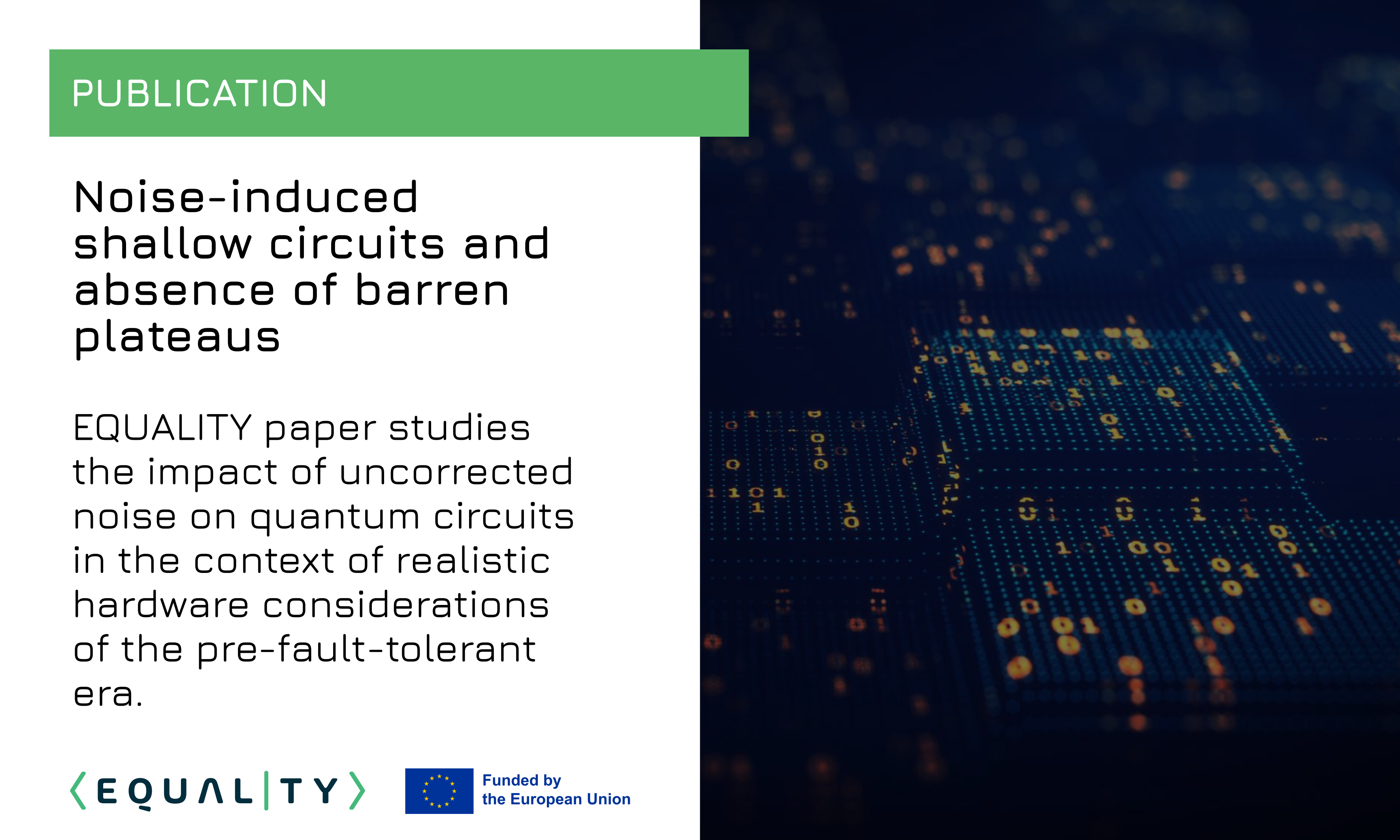

One of the most important questions for quantum computers of today is to understand the behaviour and impact of noise. It is crucial to understand whether noisy quantum computers provide any advantage, both for practically relevant problems, or even as proof-of-principle, or whether we ultimately need error-corrected logical qubits to achieve this goal.
In this work, EQUALITY partners from Inria and collaborators, motivated by realistic hardware considerations of the pre-fault-tolerant era, study the impact of uncorrected noise on quantum circuits. The authors first show that any noise `truncates' most quantum circuits to effectively logarithmic depth, in the task of computing Pauli expectation values. They then prove that quantum circuits under any non-unital noise exhibit lack of barren plateaus for cost functions composed of local observables.
By leveraging the effective shallowness, the researchers also design a classical algorithm to estimate Pauli expectation values within inverse-polynomial additive error with high probability over the ensemble. Its runtime is independent of circuit depth, and it operates in polynomial time in the number of qubits for one-dimensional architectures and quasi-polynomial time for higher-dimensional ones.
Taken together, their results showcase that, unless one carefully engineers the circuits to take advantage of the noise, it is unlikely that noisy quantum circuits are preferable over shallow quantum circuits for algorithms that output Pauli expectation value estimates, like many variational quantum machine learning proposals. Moreover, the authors anticipate that their work could provide valuable insights into the fundamental open question about the complexity of sampling from (possibly non-unital) noisy random circuits.
Read the paper by clicking on the link below.
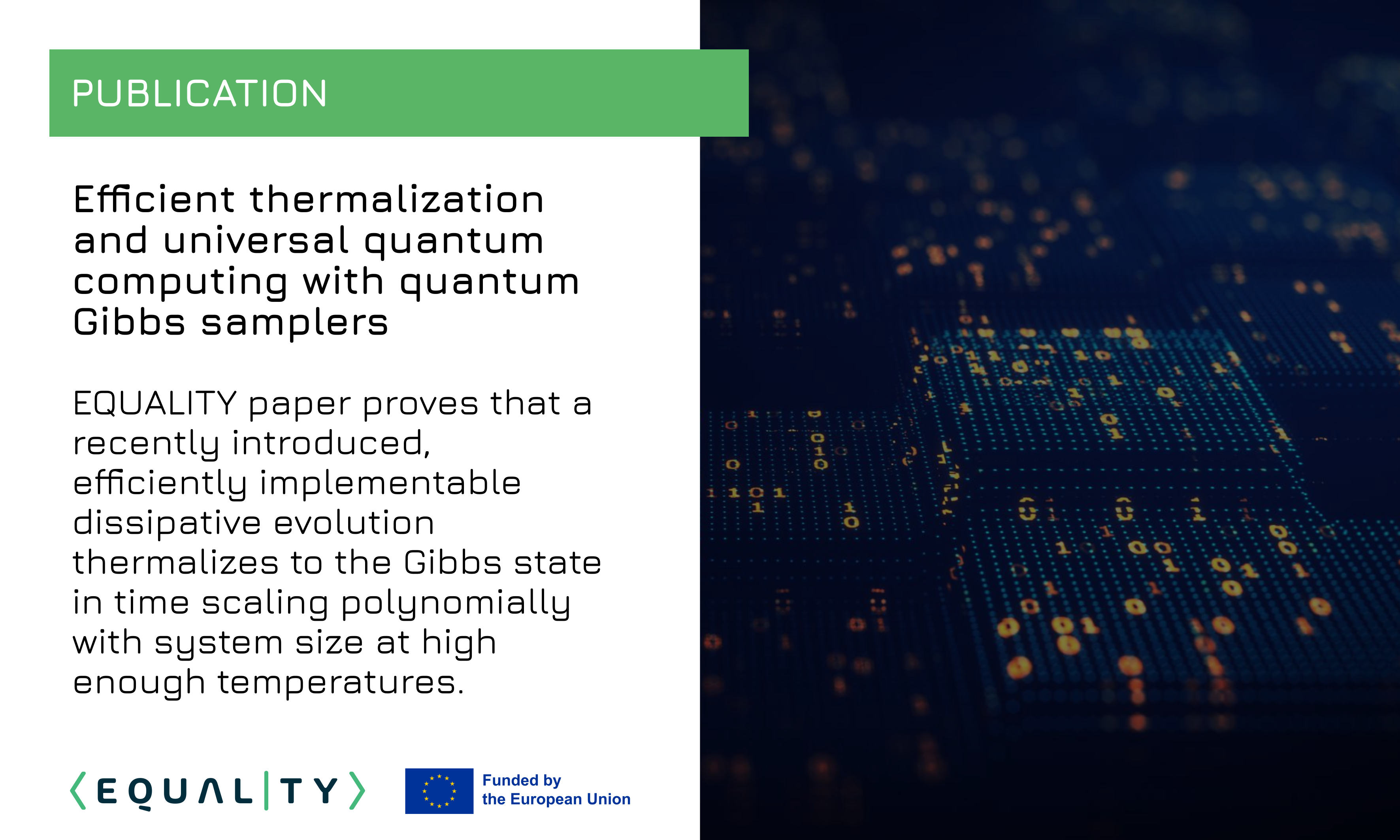

The preparation of thermal states of matter is a crucial task in quantum simulation, finding applications ranging from quantum chemistry to optimization.
In this work, EQUALITY partners from Inria and collaborators prove that a recently introduced, efficiently implementable dissipative evolution thermalizes to the Gibbs state in time scaling polynomially with system size at high enough temperatures, and for any Hamiltonian that satisfies a Lieb-Robinson bound, such as local Hamiltonians on a lattice. Furthermore, they show the efficient adiabatic preparation of the associated purifications or ``thermofield double'' states.
To the best of our knowledge, these are the first results rigorously establishing the efficient preparation of high-temperature Gibbs states and their purifications.
On a technical level, for high temperatures, their proof makes use of the mapping of the generator of the evolution into a Hamiltonian, and then analysing it as perturbation of the Hamiltonian corresponding to infinite temperature. Their results show that a family of quasi-local dissipative evolutions efficiently prepares a large class of quantum many-body states of interest and has the potential to mirror the success of classical Monte Carlo methods for quantum many-body systems.
Read the paper by clicking on the link below.
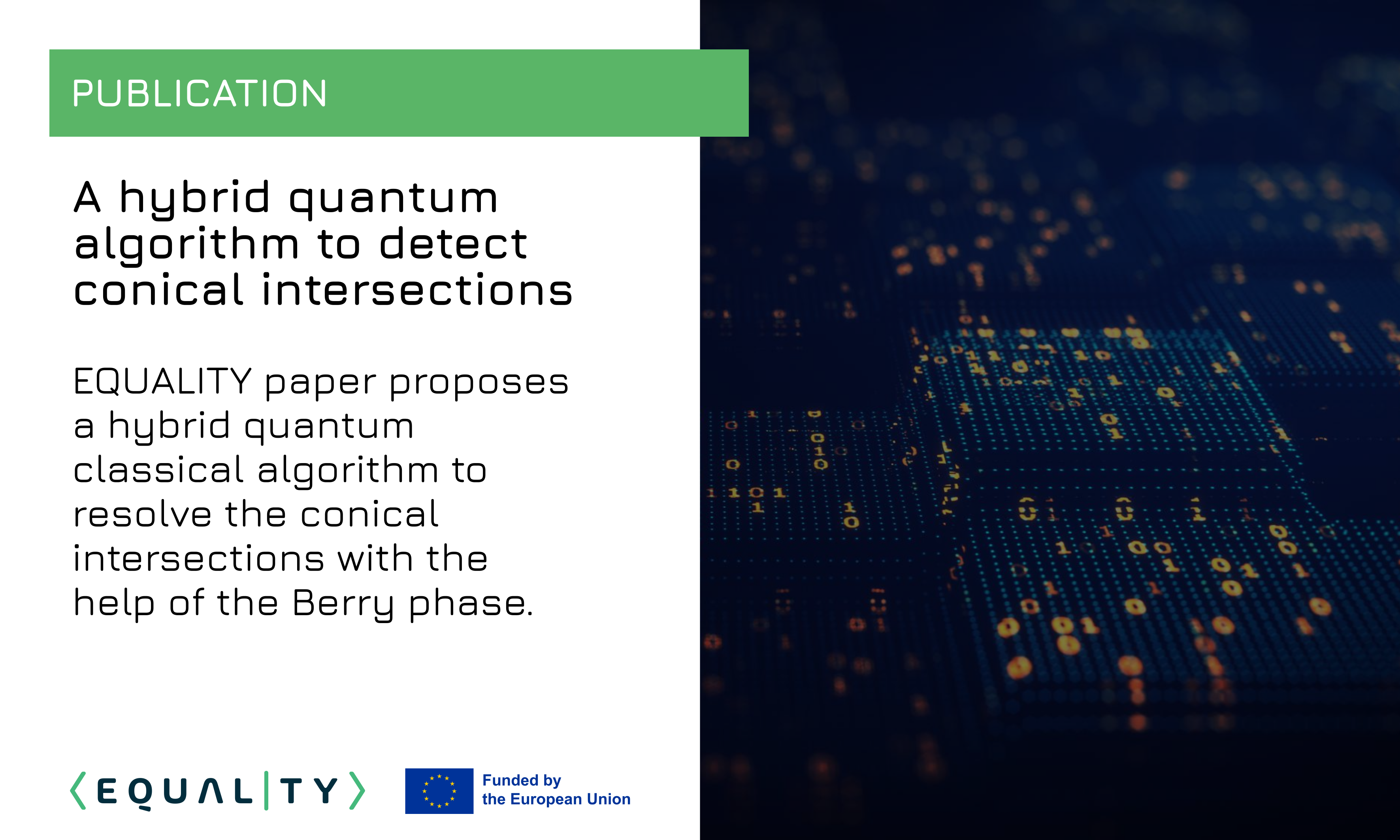

Quantum computing has long been driven by the desire to simulate interacting physical systems, such as molecules, as a novel means of investigating their properties. This is typically achieved by preparing eigenstates of molecular Hamiltonians in quantum devices which can natively store and process quantum states.
Conical intersections (CI) are degeneracy points in the Born-Oppenheimer molecular structure Hamiltonians, where two potential energy surfaces cross. They play an important role in photochemistry, as they mediate reactions which are key steps in processes such as vision or photosynthesis. Therefore, detecting the presence and resolving the properties of conical intersections is important to characterize photochemical reactions.
Nevertheless, the study of such processes requires electronic structure methods capable of accurately modelling both the shape and the relative energies of the two intersecting potential energy surfaces. This requirement poses challenges for the current available methods, but quantum computers present themselves as a highly promising option for this task.
In this work, EQUALITY partners from Leiden University, Pasqal, and collaborators propose a hybrid quantum classical algorithm to resolve the conical intersections with the help of the Berry phase. Due to its connection to the topology, such an algorithm is much more robust to errors and noise.
Read the paper by clicking on the link below.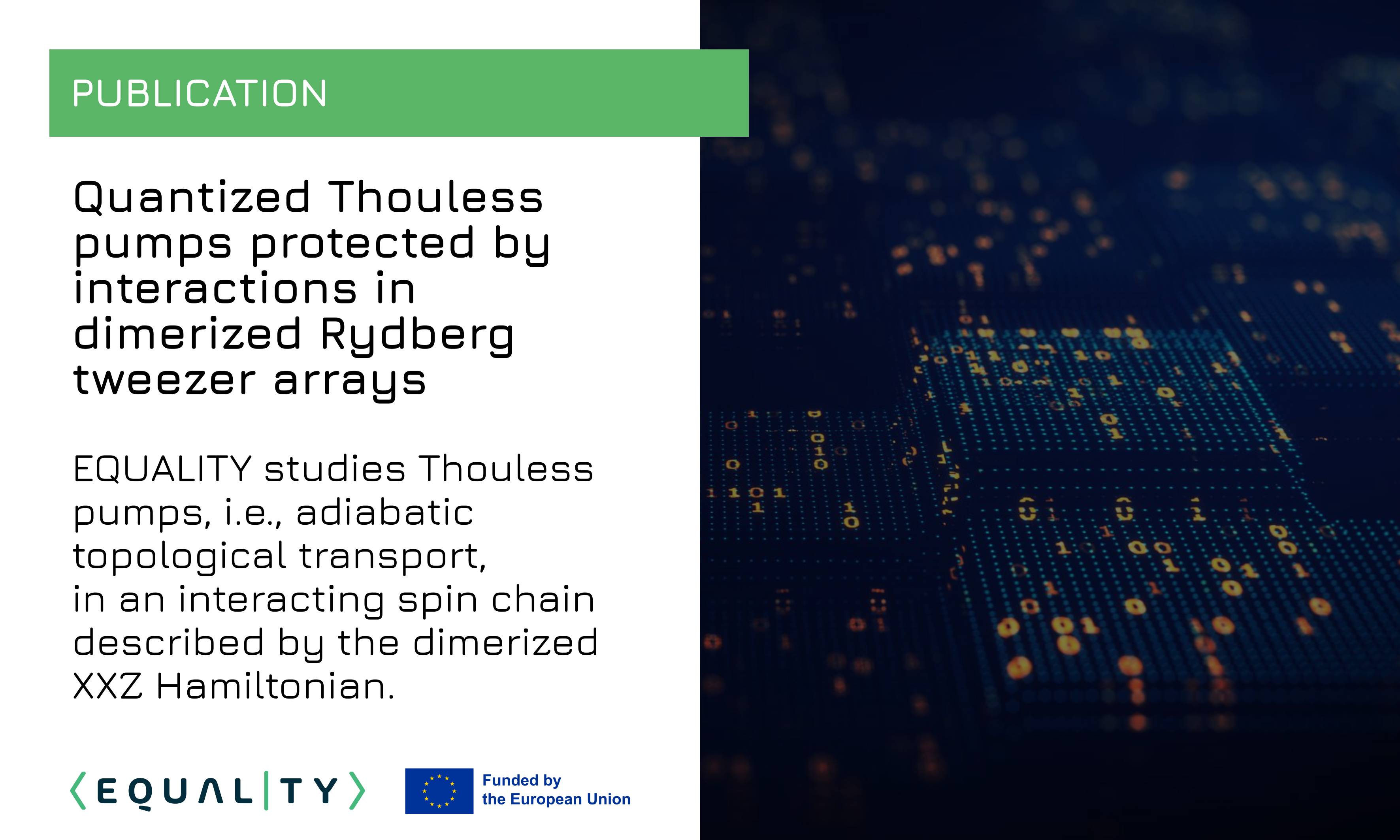

Thouless pumps allows to observe effects of the nontrivial topology in one-dimensional quantum systems. In fact, Thouless pumps show a robust quantized transport of charge during an adiabatic cycle encircling a topological singularity of the system Hamiltonian. While this phenomenon is well-understood in noninteracting systems, in terms of topological invariants of single-particle bands and their symmetries, much effort has been put recently to understand how the presence of interactions affects Thouless pumps.
In this work, EQUALITY partners from Pasqal and collaborators study Thouless pumps in an interacting spin chain described by the dimerized XXZ Hamiltonian.
In the noninteracting case, quantized Thouless pumps can only occur when a topological singularity is encircled adiabatically. In contrast, here they show that, in the presence of interactions, such topological transport can even persist for exotic paths in which the system gets arbitrarily close to the singularity.
The authors illustrate the robustness of these exotic Thouless pumps through the behaviour of the noninteracting singularity, which for sufficiently strong interactions splits into two singularities separated by a spontaneous antiferromagnetic insulator. They perform a numerical benchmark of these phenomena by means of tensor network simulations of ground-state physics and real-time adiabatic dynamics. Finally, an experimental protocol is proposed with Floquet-driven Rydberg tweezer arrays.
Read the paper by clicking on the link below.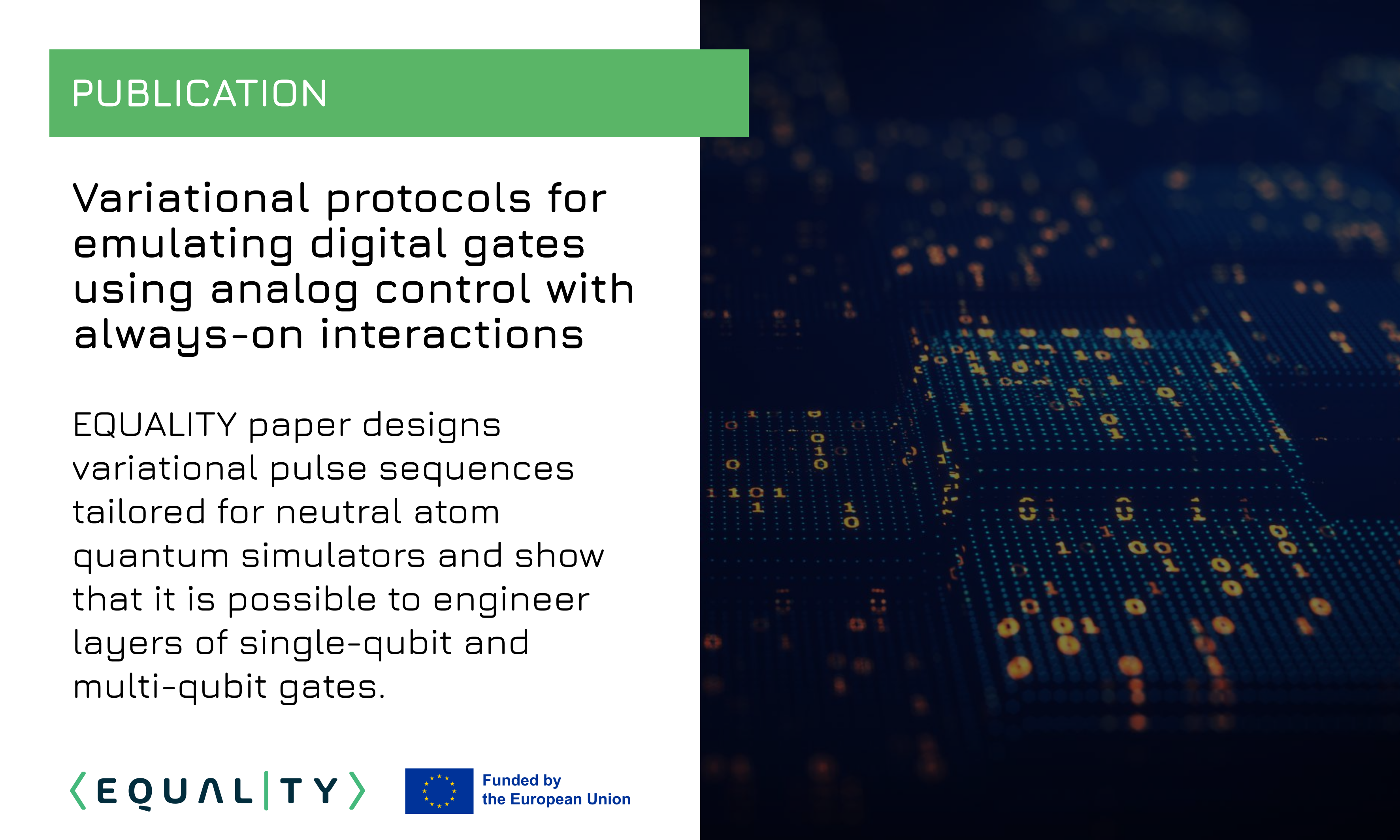

Quantum computers present an exciting alternative approach to their classical analogues that has the potential to give exponential speed ups to some very specific problems such as the simulation of quantum systems.
The most common approach to quantum computing is digital, in which a set of one-qubit and two-qubits gates are used to build a theoretically universal quantum computer. However, a fully fault-tolerant quantum computer is currently out of reach. Quantum error correction protocols have been proposed but, before they can be implemented at a meaningful scale, the number of qubits and the noise level must be improved by many orders of magnitude.
On the other hand, analog quantum computers have lower error rates than current digital computers and therefore are likely to show the first industry-relevant quantum advantage. However, since they are closely related to quantum experimental setups, analog devices are not universal, and thus more limited in their potential use cases.
In this work, EQUALITY partners from Pasqal design variational pulse sequences tailored for neutral atom quantum simulators and show that it is possible to engineer layers of single-qubit and multi-qubit gates. As an application, the authors discuss how the proposed method can be used to perform refocusing algorithms, SWAP networks, and ultimately quantum chemistry simulations.
While this theoretical protocol still has experimental limitations, it paves the way, with some further optimisation, for the use of analog quantum processors for variational quantum algorithms, including those not previously considered compatible with analog mode.
Read the paper by clicking on the link below.


The study of many-body interacting quantum systems is arguably one of the major challenges of modern physics. From a classical simulation perspective, extracting their relevant physics is a hard problem due to the exponential increase of the Hilbert space with the system size.
This fundamental bottleneck is typically circumvented in state-of-the-art numerical methods by taking advantage of the special properties of physically relevant states, as well as intrinsic system symmetries, e.g., discrete translational symmetries in crystals.
This is possible for amorphous solids, i.e., systems which feature well-defined short-range properties but lack long-range order. There are still many open questions concerning the emergent collective behaviour in amorphous materials, particularly in the quantum regime, where the numerical simulations are extremely challenging.
In this context, quantum simulators offer a promising alternative to their classical counterpart. These versatile quantum systems, used to mimic complex quantum systems in a controllable way, allow for the exploration of complex regimes that are hardly accessible with classical computers.
In this work, EQUALITY partners from Pasqal propose to simulate amorphous quantum magnets with Rydberg atoms trapped in optical tweezers and benchmark the properties of these systems in the quantum regime with a perturbative approach.
First, the authors present an algorithm to generate amorphous quantum magnets, suitable for Rydberg simulators of the Ising model, and use semiclassical approaches to get a preliminary insight of the physics of the model. In particular, they calculate mean-field phase diagrams, and use the linear-spin-wave theory to study localization properties and dynamical structure factors of the excitations.
Finally, they outline an experimental proposal based on Rydberg atoms in programmable tweezer arrays, thus opening the road towards the study of amorphous quantum magnets in regimes difficult to simulate classically.
Read the paper by clicking on the link below.

Quantum computers have dramatically improved during recent years. Despite that, they are still far from fault-tolerant computation. A number of limitations is yet to be overcome, including limited number of qubits, decoherence and gate errors. Many strategies have been developed to mitigate these issues and reach practical quantum advantages.
For instance, to directly combat size limits and reduce qubit number requirements to accessible quantities, techniques based on circuit cutting have been increasingly studied. Inspired by qubit-circuit-cutting, a question remains understudied: can a circuit be cut in depth? Or, more generally, to what extent can shallower circuits be used to tackle deeper quantum computations?
In this work, EQUALITY partners from Leiden University and collaborators investigate to what extent it is possible to mimic the performance of a deeper quantum computation by using a shallower device many times. The group proposes a method inspired by the Feynman quantum circuit simulation approach, where the circuit is cut and measured early on, and other circuits are run based on the outcomes.
This method is inefficient if applied in a straightforward manner due to the high number of possible outcomes. To mitigate this issue, the authors propose a shallow variational circuit, whose purpose is to maintain the complexity of the method within predefined tolerable limits and provide an optimization method to find such a circuit. The composition of these components of the methods is called “reduce&chop.” This approach works for certain cases of interest, and the authors believe their work may stimulate new research towards exploiting the potential of shallow quantum computers.
Read the paper by clicking on the link below.
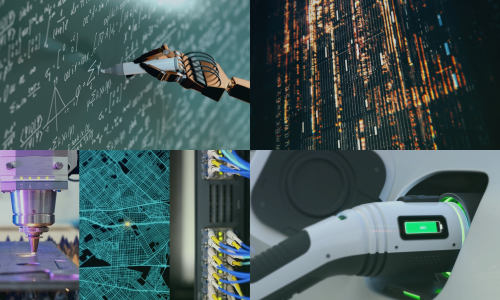

EQUALITY brings together scientists, innovators, and prominent industrial players to develop cutting-edge quantum computer algorithms to solve strategic industrial problems related to energy storage materials and systems, aerodynamics, and #space mission optimisation and data analysis.
Learn more about EQUALITY in our first project video below!
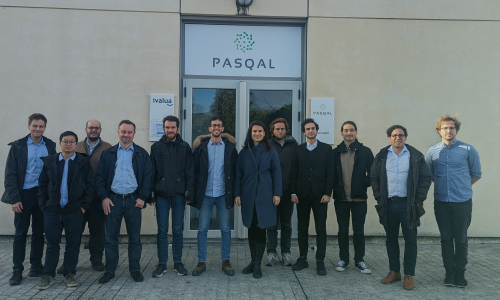

The EQUALITY consortium got together this week at PASQAL’s headquarters in France to celebrate the project’s first year. The team discussed their accomplishments in each area and their plans for the future.
The EQUALITY consortium is composed of Airbus (DE), Capgemini (DE), Da Vinci Labs (FR), Fraunhofer ENAS (DE), German Aerospace Center (DE), Inria (FR), Universiteit Leiden (NL), and PASQAL (FR). It brings together scientists, innovators, and prominent industrial players to develop cutting-edge quantum computer algorithms to solve strategic industrial problems related to energy storage materials and systems, aerodynamics, and space mission optimisation and data analysis.
These problems are computationally complex and are faced routinely by the industrial partners in the project. In many cases, the computational requirements are enormous, forcing engineers to use simplistic models or rely on expensive build-and-test cycles. Hence, the opportunity provided by quantum computers to tackle such questions computationally would give a competitive edge to the European industry, unlocking billions of euros for end-users and technology providers over the coming decades.


Introductory Paragraph
In this work, EQUALITY partners from Leiden University extend diagrammatic reasoning in monoidal categories with algebraic operations and equations. The authors achieve this by considering monoidal categories that are enriched in the category of Eilenberg-Moore algebras for a monad.
Under the condition that this monad is monoidal and affine, they construct an adjunction between symmetric monoidal categories and symmetric monoidal categories enriched over algebras for the monad. This allows the group to devise an extension, and its semantics, of the ZX-calculus with probabilistic choices by freely enriching over convex algebras, which are the algebras of the finite distribution monad. Finally, they show how this construction can be used for diagrammatic reasoning of noise in quantum systems.
Read the paper by clicking on the link below.
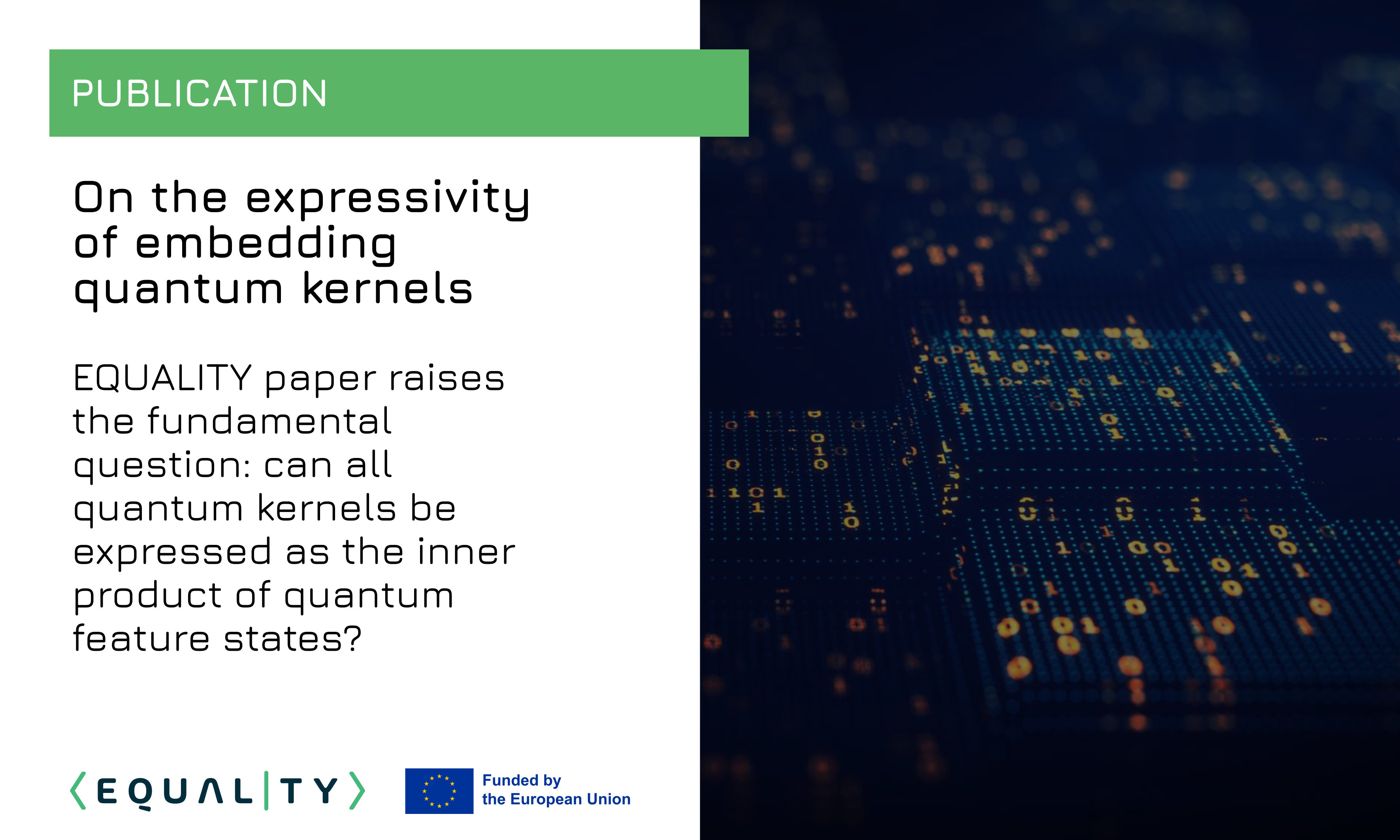

Quantum devices carry the promise of surpassing classical computers in certain computational tasks. With machine learning playing a crucial role in predictive tasks based on training data, the question arises naturally to investigate to what extent quantum computers may assist in tackling machine learning (ML) tasks.
One of the most natural connections between quantum and classical machine learning has been established in the context of kernel methods. They rely on kernels, which are inner products of feature vectors living in large feature spaces.
In this work, EQUALITY partners from Leiden University and collaborators raise the fundamental question: can all quantum kernels be expressed as the inner product of quantum feature states?
Their first result is positive: Invoking computational universality, they find that for any kernel function there always exists a corresponding quantum feature map and an embedding quantum kernel. The more operational reading of the question is concerned with efficient constructions, however.
In a second part, they formalize the question of universality of efficient embedding quantum kernels. They use the technique of random Fourier features to show that shift-invariant kernels are universal within the broad class of all kernels which allow a variant of efficient Fourier sampling.
The authors then extend this result to a new class of so-called composition kernels, which are shown to also contain projected quantum kernels introduced in recent works. After proving the universality of embedding quantum kernels for both shift-invariant and composition kernels, they identify the directions towards new, more exotic, and unexplored quantum kernel families, for which it remains open whether they correspond to efficient embedding quantum kernels.
Read the paper by clicking on the link below.
![[Blog] Tackling complex industrial problems with quantum computers](https://equality-quantum.eu/uploads/EQUALITY_web_usecases.png)
![[Blog] Tackling complex industrial problems with quantum computers](https://equality-quantum.eu/uploads/EQUALITY_web_usecases.png)
EQUALITY’s objective is to solidify the link between strategic European industries and the emerging quantum ecosystem, while also contributing to technologies which are critical to the green transition.
For that, the consortium brings together leading research groups, SMEs, and prominent industrial players towards the goal of developing quantum algorithms for real problems and testing them on real quantum hardware.
These problems have enormous computational requirements, forcing engineers either to use simplistic models or to rely on expensive build-and-test cycles. This is exemplified in aerodynamics, where it is more feasible to test models in a wind tunnel than solving the difficult equations involved in simulations.
Hence, the opportunity provided by quantum computers to solve such questions computationally promises a competitive edge for European industry.
Battery design and fuel cell design
Mobile and stationary energy storage systems are fundamental in our modern society, being found everywhere, from mobile phones to electric vehicles and homes. There is increasing demand for cheaper, higher-capacity, longer-lasting, and faster-charging energy storage systems made from more environmentally friendly materials.
The challenge in improving these systems lies mainly in understanding phenomena happening on multiple length scales, ranging from the microscopic scale (nm scale) up to the mesoscopic scale (µm scale) and up to the macroscopic scale (mm scale). Hence, their complete description requires a holistic theoretical framework, which consistently couples the atomistic description of the nanoscale with the continuum description of the meso- and macroscopic scales.
Such theoretical models usually consist of coupled (nonlinear) partial differential equations, which must be solved using numerical simulations. However, even for small systems with little complexity, such simulations consume large amounts of computational resources, often beyond the capabilities of classical computers.
Quantum computers offer a path forward for solving differential equations efficiently and adequately simulating these processes. EQUALITY will develop quantum mechanical solvers for differential equations to model whole batteries and fuel cells at the continuum level, providing a multiscale picture of their dynamics.
Battery materials discovery
Energy storage is crucial in the transition towards renewable energy sources and sustainable development. It is essential for increasing the use of renewable energy, improving grid stability, enabling the adoption of electric vehicles, providing backup power, and expanding access to energy in off-grid communities.
Although traditional battery materials, such as lithium-ion and lead-acid, have been widely used for many years, they have limitations, including low energy density, limited lifespan, prohibitive cost, and environmental concerns. And while the battery industry in Europe is expected to experience significant growth in the coming years, the raw materials necessary for their manufacturing are not sourced in the continent, putting it in a vulnerable position.
As such, there is a growing need to investigate and develop new battery materials to address these concerns. This complex and challenging process involves identifying new materials with the desired properties, optimising their properties for battery applications, and testing their performance in real-world conditions.
Therefore, by simulating battery behaviour at a microscopic level, it is possible to understand the underlying mechanisms that govern its performance. However, current simulation techniques impose computational trade-offs between precision and scale.
EQUALITY will investigate the use of quantum algorithms to simulate battery materials on an atomistic level, providing a significant speed-up in the calculations, higher accuracy due to more precise methods, and more accurate descriptions of processes between atomic species.
Solid Oxide Fuel Cell Optimisation
By 2050, as the aviation industry grows, it could consume up to a quarter of the global carbon budget necessary for limiting temperature rise to 1.5 degrees. To mitigate these emissions, hydrogen is considered a highly promising alternative fuel for powering aircraft, especially when produced from renewable energy sources.
Its use requires however the development of very efficient fuel cells, devices which transform the chemical energy of a fuel and an oxidising agent into electrical energy. Hydrogen-fed fuel cells are greener and easier to operate than combustion engines, yet scalable and powerful enough to replace the latter in different applications of autonomous power sources, especially in mobility.
Being efficient and fuel-versatile, the most promising candidate in this domain are the solid oxide fuel cells (SOFC). Despite that, there still is a need for improvement before they reach their full potential, particularly regarding the use of more cost-competitive materials, which require lower operating temperatures (currently at the 600-800°C range). This can be achieved through a deeper understanding of physical and chemical mechanisms driving the fuel cells to optimise the chemical compositions of the electrodes and electrolytes, as well as their microstructure.
However, commonly used computational methods lack the required level of detail for the problems at hand, while more precise methods are too computationally intensive. To gain a deeper understanding of SOFCs, novel computational chemistry techniques are necessary.
EQUALITY will develop quantum mechanical solvers for differential equations to model and optimise various aspects of SOFC fuel cells at the continuum level, providing a multiscale picture of their dynamics.
Aerodynamics simulations
The ambition of lowering aircraft emissions or even decarbonising air transport has become the key driver for the next generation of aircraft, triggering the study of innovative and disruptive concepts.
One way to propel the aviation industry towards zero emissions is optimising airplane frames to make them more energy efficient. It all depends on simulating in detail how air flows around the aircraft and the aerodynamic forces acting on its surfaces – including wings, fuselages, engines, landing gears, and many others – while optimising for frame weight, integrity, and performance.
These are called Computational Fluid Dynamic (CFD) simulations, and they allow for the numerical resolution of the complex flow physics, governed by the Navier-Stokes equations. However, the computational requirements of these simulations are enormous, since improving their results imply in increasing the level of detail and, consequently, the size of the problem to be solved. In turn, time, cost, and energy consumption increase exponentially. For that reason, these simulations are performed on supercomputer clusters, which have been pushed to their limits in complex simulation problems, such as the optimisation of a wing console shape.
Hence, to achieve notably better results, there is a need for more efficient ways to simulate fluid dynamics. EQUALITY will take advantage of the opportunity provided by quantum computers to solve critical aerospace problems by developing algorithms to increase the speed and precision of CFD simulations. On top of that, quantum computer algorithms can also be leveraged in multi-disciplinary design optimisation problems, such as that of load-bearing structures.
Mission optimisation for space
Over 900 Earth observation satellites are currently in orbit, grouped in constellations from different providers, and with different capabilities and aims. They are used, for example, for environmental monitoring, providing information on agricultural lands, forest cover, and weather events, which are essential to evaluate the present and future impact of climate change.
When a company operating one of these constellations receives a request to acquire an image of a given region on Earth at a given time, it faces a tough resource allocation problem. Which satellite should be assigned to take the job? When will it be capable of executing the request? Which manoeuvres need to be performed for successful acquisition?
This kind of mission planning is one of the critical procedures in operating such systems. It involves customer preferences and priorities, maximizing the number and quality of acquisitions, while also satisfying tight constraints on the platform manoeuvrability, onboard memory usage as well power and thermal limits.
With the huge costs involved in launching and operating new satellites, optimising these missions is critical to ensure that resources are efficiently used, and customer demands are satisfied. The complexity of this problem grows dramatically with the number of satellites, and solving the complete problem optimally takes too much time.
However, there is evidence that quantum approaches could outperform classical approaches for such optimisation problems. EQUALITY plans on developing powerful optimisation methods for quantum computers, which will be tested on satellite mission optimisation.
Space data analysis and processing
Earth observation satellites are in high demand nowadays, and the images they take are essential for several industries such as urban planning, agriculture, forestry, energy, defence, and many others, with novel applications being constantly developed thanks to advancements in computational approaches to image data processing, such as Machine Learning or Big Data.
Radar are extremely powerful tools for space imagery, thanks to their ability to deliver high-quality images regardless of weather and daylight conditions. They work by emitting a radio wave towards a target and collecting back its echo, the wave reflected on the target’s surface. By knowing the exact wave pattern sent out and the position of the sensor, it is possible to generate an image out of the raw data by measuring the time it takes for the radio wave to go from the satellite to the surface and back again.
In satellites, multiple radio signals are sent during the flight along the satellite's ground track, and various echoes are received from the area of interest. This technique is called synthetic aperture radar (SAR), and it stands out for its high resolution, which comes, however, with a high computational cost.
The raw SAR data is an overlay of complex echo patterns that must be processed by sophisticated and computing-intensive algorithms responsible for generating an image. Adding to the computational cost are the various error corrections due to distortions in the data caused by atmospheric effects and the sensor's timing and position errors.
Quantum computers have the potential to significantly accelerate the resolution of these computational issues. EQUALITY will explore the use of quantum computers to speed up the post-processing of satellite-based image acquisition by applying machine learning techniques to SAR data processing.
Learn more from EQUALITY's deliverable in the link below.
![[Blog] On the realisability of quantum advantage](https://equality-quantum.eu/uploads/EQUALITY_website_thumb2.jpg)
![[Blog] On the realisability of quantum advantage](https://equality-quantum.eu/uploads/EQUALITY_website_thumb2.jpg)
By Farhang Hadad Farshi, Quantum Technology Expert at Da Vinci Labs.
Quantum computers are believed to be capable of performing efficiently certain computational tasks that are considered to be intractable for classical computing machines. This advantage is rooted in the quantum computer’s capacity to leverage interference - the most fundamental hallmark of quantum behavior.
To be more precise, the algorithms designed for quantum computers orchestrate intricate patterns of interference enabling them to solve certain problems in a significantly shorter period of time. This means that for a quantum computer, the solution time grows at a significantly slower rate than that of a classical computer, as the size of the problem increases.
A vast collection of computationally hard problems have been proposed to benefit from such asymptotic quantum speedup ranging from cryptanalysis, chemistry, and materials science, to optimization and machine learning. While asymptotic speedup is essential, it alone cannot ensure practical quantum advantage.
It is of central importance to also consider the fundamental limitations that bound the performance of a realistic quantum computer in order to assess whether a tangible benefit over classical computers can be achieved. This gives rise to a key question: which class of the proposed applications are likely to pan out?
A recent study [1] has provided a comprehensive answer to this question by considering some of the fundamental limitations linked with the near-future quantum computers such as the number of gate operations per unit time that determines the upper bound on the input/output bandwidths.
Having an optimistic outlook for quantum computers, they find that the applications that are more likely to yield a practical quantum advantage are those that allow exponential speedup such as quantum simulation applied in chemistry and material science, as well as cryptanalysis based on Shor's algorithm.
More importantly they conclude that a large range of problems with quadratic speedups such as many current machine learning approaches, or solving systems of nonlinear equations that model turbulence, are unlikely to yield practical quantum advantage unless significant algorithmic improvements are made.
As a considerable number of scientific and industrial applications, including the modeling of turbulent aerodynamics and space mission optimization, fall under the category of problems with non-exponential (quadratic) speedup, it is crucial to explore the possibilities for significantly upgrading the algorithms for such applications.
EQUALITY is precisely designed to explore such possibilities of developing cutting-edge algorithms for solving practical industrial problems using realistic quantum computing machines.
[1] T. Hoefler, T. Häner, M. Troyer, Communications of the ACM, 66, 5, pp 82-87, 2023. DOI: 10.1145/3571725.
![[In the Media] IT for Business: A consortium to open up industrial opportunities for quantum technology](https://equality-quantum.eu/uploads/EQUALITY_website_thumb3.jpg_.jpg)
![[In the Media] IT for Business: A consortium to open up industrial opportunities for quantum technology](https://equality-quantum.eu/uploads/EQUALITY_website_thumb3.jpg_.jpg)
The EQUALITY project and our partner Da Vinci Labs were highlighted in the May issue of the french magazine IT for Business Magazine.
Read an excerpt:
"In a forest on the outskirts of Amboise (and near Le Clos Lucé, where Leonardo da Vinci lived), the Da Vinci Labs building will be completed in 2024, and will house the Equality consortium, among several other major public/private research projects. Members include Airbus, Capgemini, Fraunhofer ENAS (Electronic nano systems), German Aerospace Center (DLR), Inria, Leiden University, and French quantum computer manufacturer Pasqal.
The consortium has set itself the goal of developing quantum algorithms for industrial applications in a number of disciplines, all of which have a bearing on environmental protection. Equality is logically targeting those that could benefit from the speed of quantum computing: aerodynamic profiling, battery design, fluid dynamics, optimization of space missions, design of new materials, and so on."
The complete article is available online in the link below (in French).
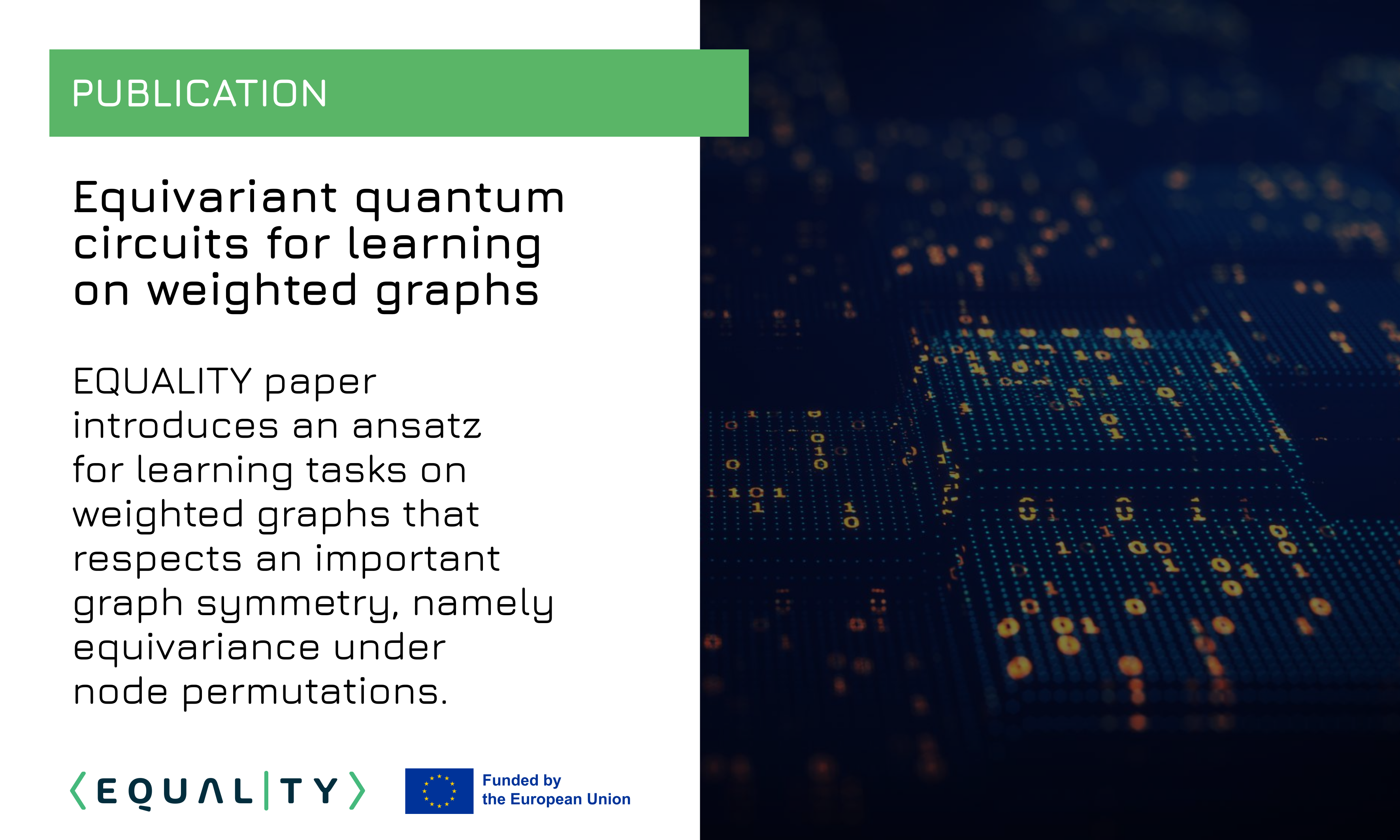

Variational quantum algorithms, when a parametrized quantum circuit (PQC) is optimized by a classical algorithm to solve a specific problem, are expected to be the leading candidate for near-term quantum advantage. These hybrid quantum-classical algorithms can be applied in a variety of contexts, and there is hope that their hybrid nature can make them robust to noise to some degree.
When training a PQC in this setting to solve a specific problem, the right choice of circuit structure, also known as the ansatz, is of key importance the trainability and performance of the algorithm. For quantum machine learning however, it is largely unknown which type of ansatz should be used for a given type of data.
In this work, EQUALITY partners from Leiden University and collaborators introduce an ansatz for learning tasks on weighted graphs that respects an important graph symmetry, namely equivariance under node permutations.
The authors evaluate the performance of this ansatz on a complex learning task, namely neural combinatorial optimization, where a machine learning model is used to learn a heuristic for a combinatorial optimization problem. They analytically and numerically study the performance of the model, and their results strengthen the notion that symmetry-preserving ansatzes are a key to success in QML.
This work motivates further study of “geometric quantum learning” in the vein of the classical field of geometric deep learning, to establish more effective ansatzes for QML, as these are a pre-requisite to efficiently apply quantum models on any practically relevant learning task in the near-term.
Read the paper by clicking on the link below.
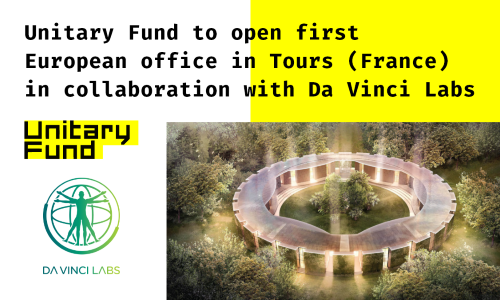

Unitary Fund, a non-profit organization supporting the quantum technology ecosystem, will open its first European office in Tours, France. Da Vinci Labs, a deeptech accelerator for quantum, AI, and synthetic biology, acted as an incubator for Unitary Fund’s European operations, providing incorporation and fundraising advisory services.
There is rapid growth across quantum technology, and the vision for a robust quantum industry increasingly resonates with scientists, engineers, investors, and corporations. Still, there are challenges to overcome as researchers need to develop error correction, scalable hardware technologies, useful algorithms with provable advantages, ways to benchmark and project the performance of heuristic algorithms, and more.
Some of these challenges are well addressed by academic and industry players. However, others are public goods that help everyone but that don't stand alone as businesses. These are the open development tools, standards, benchmarks, interfaces, educational and training materials, skill sharing networks, open source communities, mentorship networks and more that form the soil from which a rich industry and ecosystem can grow.
Unitary Fund’s mission is to foster the quantum ecosystem with a microgrant program funding explorers worldwide to work on quantum projects like open-source quantum software, educational materials and workshops, a new quantum sensor prototype, and much more. Unitary Fund has supported open-source projects like Pulser (a framework for composing, simulating and executing pulse sequences for neutral-atom quantum devices), mitiq (a compiler for error-mitigated quantum programming) and metriq (a platform for sharing quantum technology benchmarks).
Xavier Aubry, Da Vinci Labs' Founder and Managing Director, commented:
“Unitary Fund has the ambition to be the equivalent of the Linux Foundation for the quantum industry. As the ecosystem matures, open-source software platforms will be key to supporting use cases and applications of quantum technology. That’s why we decided to collaborate with Unitary Fund and help set up their European office in France.”
Nathan Shammah, CTO of Unitary Fund, comments: “The French quantum ecosystem has risen to global prominence, thanks to the excellence of its research and its network supporting deeptech transfer, with players like Quantonation. A first generation of quantum hardware spin-offs like Pasqal and Quandela, are committed to developing open source infrastructure. We’re looking forward to further collaboration with the Da Vinci Labs through a shared long-term vision of a sustainable and open quantum ecosystem in Europe.”
Will Zeng, Unitary Fund Founder and President, remarks: “We have supported innovative teams through our microgrants and hackathons for years now. With the help of Da Vinci Labs, we are excited to expand our commitment to developing the quantum ecosystem in France and in Europe.”
About Unitary Fund
Unitary Fund is a 501(c)(3) non-profit whose mission is to create a quantum technology ecosystem that benefits people around the world. We believe that expanding the pool of people working on quantum technologies is a way to ensure that the benefits of these tools are widely, swiftly, and equitably distributed. We primarily use two major programs to pursue this mission. Through Unitary Labs, we work on in-house projects that help the ecosystem as a whole. Through our microgrant program, we fund an inclusive community of explorers across the world to work on quantum technologies.
About Da Vinci Labs
Da Vinci Labs is a research and incubation structure inspired by Leonardo da Vinci. Its interdisciplinary and humanistic approach aims to respond competitively to the ecological challenges of tomorrow and to bring out the future champions of deeptech, in particular in the field of quantum technologies, artificial intelligence and synthetic biology. To do this, Da Vinci Labs participates in European collaborative research projects and builds a technological infrastructure in Touraine, which will be made available to researchers and entrepreneurs ready to tackle our major societal challenges.
https://www.davincilabs.eu/en/
![[Blog] EQUALITY celebrates the World Quantum Day](https://equality-quantum.eu/uploads/EQUALITY_web_quantumday.png)
![[Blog] EQUALITY celebrates the World Quantum Day](https://equality-quantum.eu/uploads/EQUALITY_web_quantumday.png)
The World Quantum Day, celebrated on April 14th, is an initiative from quantum scientists all over the planet to engaging the public in the understanding of quantum science and technology.
Quantum mechanics is the theory that allows us to describe Nature in its most fundamental level, that of the elementary particles and forces that constitute the Universe. In doing so, it is at the origin of a veritable technological revolution through many technologies that helped shape society and are ubiquitous in our lives today.
This includes modern electronics systems, such as computers and mobiles phones; the global positioning system (GPS); magnetic resonance imaging (MRI) machines; lasers; and many others. They are part of the so-called first generation of quantum technologies, which rely on a limited control of quantum effects.
However, a second generation of quantum technologies is already on the horizon, taking full advantage of the behaviour of matter on the atomic scale and offering new capabilities for computation, communication, sensors, and other applications.
Regular computers are built on transistor-based bits that can assume only assume distinct values at a time (either “0” or “1”). Meanwhile, quantum mechanics allows the quantum computer’s bits, or qubits, to be in a special physical state called superposition, which means they can exist as “0” and “1” at the same time.
This and other quantum properties, allow quantum computers to perform certain operations that are too difficult, or even impossible, for regular computers. These incredible machines represent a potentially massive market opportunity in several sectors, including aerospace, chemistry, pharmaceuticals, finance, and many others.
And as they approach widespread commercial application, these incredible machines represent a potentially massive market opportunity in several sectors, including aerospace, chemistry, pharmaceuticals, finance, and many others.
In the aerospace sector, quantum computing can help optimize the design for air- and spacecrafts, or the best routes for missions, allocating resources optimally to minimize disruptions. For the chemical industry, it will be able to better predict and simulate the properties and behaviour of new molecular structures, such as materials for the new generation of batteries.
In the pharmaceutical industry, quantum computers will accelerate drug development by identifying and validating molecular structures, such as protein folding, and interaction their interactions. Even in the finance sector, they can help institutions optimize investment portfolios, characterize anomalous transactions, and detect fraud.
The EQUALITY consortium brings together scientists, innovators, and prominent industrial players with the mission of developing cutting-edge quantum computer algorithms to solve strategic industrial problems related to energy storage materials and systems, aerodynamics, and space mission optimisation and data analysis.
These problems are computationally complex and are faced routinely by the industrial partners in the project. In many cases, the computational requirements are enormous, forcing engineers to use simplistic models or rely on expensive build-and-test cycles.
Hence, the opportunity provided by quantum computers to tackle such questions computationally would give a competitive edge to the European industry, unlocking billions of euros for end-users and technology providers over the coming decades.
The day of April 14th was chosen for the World Quantum Day as a reference to 4.14, the rounded first digits of Planck’s constant: 4.135667696…×10^−15 eV.s, the fundamental constant governing quantum physics.
Learn more in the link below.
![[In the Media] BFMTV: AI, quantum and synthetic biology under development at Da Vinci Labs](https://equality-quantum.eu/uploads/bfmtv.png)
![[In the Media] BFMTV: AI, quantum and synthetic biology under development at Da Vinci Labs](https://equality-quantum.eu/uploads/bfmtv.png)
Project partner Xavier Aubry, from Da Vinci Labs, presents the EQUALITY Project in the French TV channel BFMTV.
Click below to watch the interview (in French).
![[In the Media] L’Usine Nouvelle: The European EQUALITY project aims to put quantum algorithms to work for industry](https://equality-quantum.eu/uploads/EQUALITY_website_thumb1.jpg)
![[In the Media] L’Usine Nouvelle: The European EQUALITY project aims to put quantum algorithms to work for industry](https://equality-quantum.eu/uploads/EQUALITY_website_thumb1.jpg)
The EQUALITY Project is highlighted in an article in the French website and magazine L'Usine Nouvelle and IT Industries and Technology.
"Funded to the tune of €6 million by Europe, the Equality project aims to design quantum algorithms to speed up the resolution of problems in aerodynamic simulation, materials modelling and fluid mechanics. The French contributors are Inria, Airbus and Pasqal, which will provide quantum computers to support the development of these algorithms."
Read more below (in French).
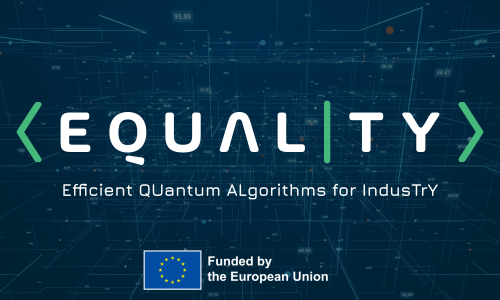

EQUALITY consortium selected by the EU’s Horizon Europe Program to develop quantum algorithms for industrial applications
The project brings together scientists, innovators, and industrial players and will receive a cumulative six-million-euro funding from the European Commission over the next three years.
Berlin, February 23, 2023 – The EQUALITY¹ consortium comprising Airbus, Capgemini, Da Vinci Labs, Fraunhofer ENAS, German Aerospace Center, INRIA, Leiden University and PASQAL, has been selected by the EU’s key funding program for research and innovation, Horizon Europe, to develop innovative quantum computer algorithms that are aimed to solve strategic industrial problems.
By transforming current industrial interest into widespread adoption, EQUALITY’s objective is to solidify the link between strategic European industries and the emerging quantum ecosystem, while also contributing to technologies which are critical to the green transition. This project is one of three submissions selected out of a total of 51. The partners will receive a cumulative six-million-euro funding from the European Commission over the next three years.
The consortium will target eight industrial use cases that can benefit from the quantum-enabled speed-up – each computationally complex and faced routinely by the industrial partners. These are airfoil aerodynamics, battery design, fluid dynamics, space mission optimization, materials design, multidisciplinary optimization, space data analysis and fuel cell design. The computational requirements are enormous, forcing today’s engineers to use simplistic models or rely on expensive build-and-test cycles. This is exemplified in aerodynamics, where it is more feasible to test models in a wind tunnel than solving the difficult equations involved in simulations. Similarly complex situations are also found in Li-ion batteries and fuel cell simulations.
The opportunity provided by quantum computers to tackle such questions computationally promises a competitive edge for European industry. Moreover, energy-efficient aerodynamics and more durable and affordable batteries are critical to propelling these industries towards zero emissions.
Born in Europe over 100 years ago, quantum physics brought forth a technological revolution, enabling inventions such as semiconductors, lasers, fibre optics, and other technologies that are today ubiquitous in our lives.
Quantum computers can perform several operations that are too difficult, or even impossible, for regular processors. And as they approach widespread commercial application, they open up market opportunities in several sectors.
The use of today’s quantum hardware, however, requires grappling with the limitations of this nascent technology. These bottlenecks limit the application of quantum computers to solve industrial problems.
¹EQUALITY stands for Efficient ‘QUAntum ALgorithms for IndusTrY’
Note to Editors: EQUALITY consortium is led and coordinated by Capgemini. Communication and dissemination on the program are led by Da Vinci Labs. Contact us using this form.

About Airbus
Airbus is an international pioneer in the aerospace industry and a leader in designing, manufacturing and delivering aerospace products, services and solutions to customers on a global scale. We believe that it’s not just what we make, but how we make it that counts; promoting responsible, sustainable and inclusive business practices and acting with integrity. Our people work with passion and determination to make the world a more connected, safer and smarter place, on the ground, in the sky and in space.
About Capgemini
Capgemini is a global leader in partnering with companies to transform and manage their business by harnessing the power of technology. The Group is guided everyday by its purpose of unleashing human energy through technology for an inclusive and sustainable future. It is a responsible and diverse organization of 360,000 team members in more than 50 countries. With its strong 55-year heritage and deep industry expertise, Capgemini is trusted by its clients to address the entire breadth of their business needs, from strategy and design to operations, fueled by the fast evolving and innovative world of cloud, data, AI, connectivity, software, digital engineering and platforms. The Group reported in 2022 global revenues of €22 billion.
www.capgemini.com | Get The Future You Want
About Da Vinci Labs
Da Vinci Labs is a research and incubation structure inspired by Leonardo da Vinci. It’s interdisciplinary and humanistic approach aims to respond in a competitive way to the ecological challenges of tomorrow, and to bring out the future champions of deeptech, in particular in the field of quantum technologies, artificial intelligence and synthetic biology. To do this, Da Vinci Labs participates in European collaborative research projects and builds a technological infrastructure in Touraine which will be made available to researchers and entrepreneurs ready to tackle our major societal challenges.
About Fraunhofer Institute for Electronic Nano Systems
The Fraunhofer Institute for Electronic Nano Systems ENAS is the specialist and development partner in the field of Smart Systems and their integration for various applications. Fraunhofer ENAS has specialized on the challenge of combining micro and nano sensors, actuators and electronic components with interfaces for communication and a self-sufficient energy supply to form smart systems, thus supporting the Internet of Things and the ongoing digitalization. Fraunhofer ENAS develops single components, manufacturing technologies and system concepts, system integration technologies and actively supports the technology transfer for and with its customers.
About German Aerospace Center
DLR is the Federal Republic of Germany’s research centre for aeronautics and space. They conduct research and development activities in the fields of aeronautics, space, energy, transport, security and digitalisation. The German Space Agency at DLR plans and implements the national space programme on behalf of the federal government. Two DLR project management agencies oversee funding programmes and support knowledge transfer. Climate, mobility and technology are changing globally. DLR uses the expertise of its 55 research institutes and facilities to develop solutions to these challenges.
About INRIA
As a technology institute, Inria supports the development of numerous software products, sometimes making a global impact via the open source model. Because technology start-ups are powerful channels for research outcomes, Inria also supports entrepreneurial risk-taking and start-up creation (Deeptech). Firmly established on major university campuses and in industrial ecosystems, the Institute is at the heart of the digital revolution.
About Leiden University
Leiden University was founded in 1575 and is one of the leading international research universities in Europe. The University has seven faculties and a campus in both Leiden and The Hague. The university motto is Praesidium Libertatis – Bastion of Freedom. And there are five broad clusters of science areas distinguished (fundamentals of science; health and wellbeing; languages, cultures and societies; law, politics and administration; life sciences) and one overarching research theme (artificial intelligence).
About PASQAL
PASQAL builds quantum computers from ordered neutral atoms in 2D and 3D arrays to bring a practical quantum advantage to its customers and address real-world problems. PASQAL was founded in 2019 by Georges-Olivier Reymond, Christophe Jurczak, Professor Dr. Alain Aspect, Nobel Prize Laureate Physics, 2022, Dr. Antoine Browaeys, and Dr. Thierry Lahaye. PASQAL has secured more than €40 million in financing, combining equity and non-dilutive funding.
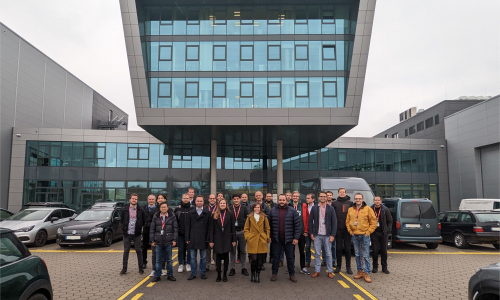

The EQUALITY project's kickoff meeting took place on Nov. 29th in Hamburg, Germany. It was a pleasure meeting all partners! Follow us on social media to keep up with our progress in solving strategic #industrial problems using quantum computing!
The EQUALITY consortium is composed of Airbus (DE), Capgemini (DE), Da Vinci Labs (FR), Fraunhofer ENAS (DE), German Aerospace Center (DE), Inria (FR), Universiteit Leiden (NL), and PASQAL (FR).
